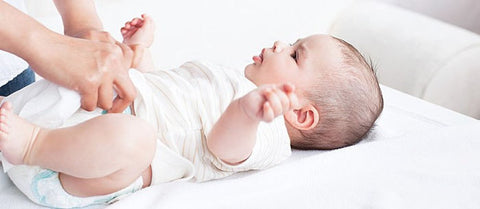When we become parents, there are always all kinds of things to bother us, especially when we become parents for the first time, we often feel overwhelmed, the first thing we have to learn as parents is to change the baby's diaper.
While the frequent (sometimes hourly) diaper changes may not be your favorite part of the mommy or daddy job, they're still part of the baby care package. And it's good for baby too, since changing a diaper whenever it's wet or messy helps prevent irritation and diaper rash.
The preparations
Clean diapers. It's always good to have a couple of spares handy when you're changing diapers.
Clean cotton balls, washcloths or wipes. For newborns under 1 month old and those with diaper rash, use warm water and a cotton ball to clean baby off and a washcloth for drying (you can also try using hypoallergenic wipes for newborns without diaper rash to start, if you prefer). For older infants, use pre-moistened wipes; look for those that are hypoallergenic and free of fragrance and alcohol.
A change of clothes for baby. You might need one if the diaper has leaked (it happens!).
Clean diaper wraps or waterproof pants if you're using cloth diapers.
Ointment to prevent and/or soothe diaper rash. If baby has diaper rash, it creates a barrier between that tender bottom and skin-irritating poop and pee. No need for lotions, baby oil or powder. Remember, though, that you can't use many diaper rash creams and ointments with cloth diapers.
A loving touch. Your gentle voice (talking or singing) and touch can make diaper changes easier on your baby -- and easier on you too.
A distraction. Keep a favorite toy visible and even a music box or mechanical toy for distraction, especially if you've got a squirmy baby.
Once you've got everything you need ready to go, wash and dry your hands. If that's not possible, give them a good swipe with a diaper wipe.
The changing guide
There are several steps parents can take when changing a diaper.
Step 1: Place your baby on a clean, soft, safe surface
A changing pad and a changing pad cover.The changing pad will keep your baby as still as possible while changing the diaper.The changing pad cover provides a comfortable and soft environment for your baby. They have lots of benefits.
Making use of a changing table pad is beneficial for numerous reasons as these are designed to ensure that your baby is secured firmly in place as you change their diaper.
While the actual changing pad is not very expensive at all, the costs can really start to add up especially if you need to keep replacing them. The purpose of using a cover is to simply protect these pads whenever your baby needs to be ch.langed. This way you can always ensure a clean changing station as your child will most definitely appreciate it.
No matter where you're changing diapers, make sure to keep one hand on the baby at all times, even before your little one has started rolling over. Strapped-in babies also should remain with arm's reach.
Step 2: Open up the diaper and clean your baby
Unfasten the diaper and survey the scene, then follow the same basic rules for both boys and girls:
For a wet diaper: Fold the dirty diaper underneath the baby (so the clean, outer side is now under his or her bottom) and wipe the area.
For a poopy diaper: Wipe as much as possible with the diaper itself, then fold it underneath, as above. Lift the legs and clean baby's front well with warm water or wipes, being sure to get into all the creases. Then lift both legs and clean baby's bottom thoroughly.It's important that we clean the baby's bottom.
There are some very good reasons for this, but prime among them is the presence of dangerous bacteria and other contaminants like rotavirus, norovirus, salmonella which can quickly spread from surfaces to babies, other family members, or you. “Any debris left anywhere on a changing table or piece of clothing can become a breeding ground,” says Dr. Jennifer Trachtenberg, a fellow of the American Academy of Pediatrics.
Once baby's diaper area is clean, slip the soiled diaper out and put a fresh one under baby before releasing baby's legs. Pat baby dry before putting on the clean diaper or any diaper rash creams. If the umbilical cord is still attached and you aren't using special newborn diapers, fold the diaper down to expose the area to air and avoid getting it wet. Fasten it tightly to avoid leaks, but not so tightly that irritation occurs (you'll notice the telltale red marks during the next diaper change). For disposables, the tabs go in the back, underneath baby, and then wrap around to front.
Step 4: Dress baby
Now that you're done, change baby's clothes and/or sheets as needed (and it will probably be needed, quite often!) or re-dress him or her.
Step 5: Wash your hands again
Finish by washing your hands again (use hand sanitizer if soap and water aren't available).


